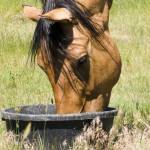Should Beet Pulp or Vegetable Oil Be Fed to Performance Horses?

This experiment was designed to compare a traditional high-grain diet to diets that provide 15% of the total caloric intake from either vegetable oil (FAT) or beet pulp (FIBER) in performance horses.
Results showed that blood glucose was significantly lower in the FAT horses during the three hours post-feeding as compared to either the CONTROL or FIBER fed horses. Insulin was also significantly lower in the FAT horses both post-feeding and throughout exercise. Cortisol was significantly lower in the FAT horses as compared to the CONTROL horses during exercise. No differences were found in lactate, total protein, hematocrit, or triglycerides during exercise.
Substituting 15% of the digestible energy as vegetable oil had a greater effect on metabolic response to exercise than a 15% substitution of beet pulp. Beet pulp provided adequate energy to maintain weight and horses performed as well as the horses on the high-starch diet. Therefore, it is reasonable to substitute 15% of the energy of the diet of a performance horse with a highly fermentable fiber, but it may not have the performance advantages of 15% added oil.
This report of KER’s 1998 research was published in Proceedings of the 16th Equine Nutrition and Physiology Society Symposium.
Read the entire research paper, titled A Comparison of Grain, Vegetable Oil, and Beet Pulp as Energy Sources for the Exercised Horse.








